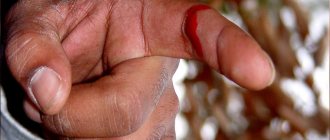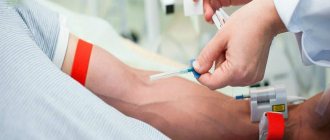Every year in the world the number of people suffering from diabetes mellitus increases significantly, which gives the right to call this disease a “non-infectious epidemic”. A significant percentage of patients learn about their disease by chance, not knowing that they have been living with high blood sugar levels for a long time.
However, there are a number of symptoms that may suggest diabetes mellitus even before a laboratory test can detect changes in the blood test.
Common symptoms of diabetes
There are common symptoms of diabetes, called “red flags,” that allow doctors to suspect the disease and refer the patient for an initial examination to check for elevated blood sugar levels.
- Frequent urination. The kidneys respond to increased levels of glucose and strive to excrete it during diuresis, and a large amount of water is excreted along with glucose molecules.
- Thirst. An increase in a person's need for fluid is the main companion of diabetes. High glucose levels lead to constant excretion of excess sugar in the urine, and the body becomes dehydrated. The main defense mechanism for dehydration is thirst - signals are sent to the brain that it is necessary to replenish water reserves. A person begins to drink much more often than before, sometimes up to 8–10 liters per day.
- Weight loss. Despite the fact that many people with type 2 diabetes are overweight, at the onset of the disease, progressive weight loss begins with a normal lifestyle and without changing the diet.
How to determine sugar level in urine
If diabetes is diagnosed at the wrong time, it will most likely lead to various complications.
Factors that influence the progression of the disease may include irregular exercise, poor diet, inconsistent glucose testing, and non-adherence to medication.
During diabetes therapy, it is very important to adhere to all the rules that can maintain normal glycemia.
If you suspect you have diabetes, but still do not want to see a doctor, you can try to detect the level of sugar in your urine using improvised means.
To determine the level of sugar in urine, there are special strips that can be purchased at the pharmacy. All diabetics use them.
It is important to do the test in the morning on an empty stomach and after eating. The strip is coated with a special reagent that changes color when it comes into contact with urine.
The strip should be placed in a jar of urine or simply held under the stream. Do not touch the test strip with your hands or wipe it with a towel.
You can usually get results within a minute.
Depending on the color of the strip, the level of sugar in the urine is determined. However, such a check is not informative for type 1 diabetics, as well as for people over 50 years of age.
Often test strips can only react to very large amounts of sugar - more than 10 mmol per liter. This amount is called the renal threshold. If the test shows more sugar in the urine than this indicator, it means that glucose is leaking into the urine and the body is not able to cope with it.
There are also strips that measure blood sugar levels. To obtain an analysis, you need to wash your hands thoroughly, since a small amount of sugar on the surface of the skin can distort the results.
A clean finger must be pierced with a sterile needle and lowered down so that a drop of blood appears. Apply the test strip to the drop so that the entire reagent area is covered with blood.
After this, you need to wait a while until the color appears on the strip. Each color corresponds to a certain amount of sugar - this can be found on the packaging of the test strips.
Glucometers, which also work with test strips, are widely used. The strip is placed in a drop of blood and then inserted into the device. It accurately determines blood sugar levels. Some modern models are equipped with a memory function, a sound signal, and the ability to remember results.
Normal sugar levels range from 3.3 to 6.1 mmol per liter if the test is taken on an empty stomach. After eating, the amount of sugar can increase to 9 and 10 mmol per liter. Some time after eating (1-2 hours), sugar returns to normal again. If your readings are significantly higher than normal, don’t wait, see a doctor immediately!
Little-Known Symptoms of Diabetes
Complaints of thirst, increased urination and weight loss are frequent accompaniments of diabetes and immediately lead the doctor to suspect a serious illness. However, there are also little-known signs of diabetes, which, however, can help to suspect this diagnosis and allow timely treatment. Even at home, you can determine the risk of diabetes by detecting symptoms such as:
- Increased fatigue and decreased performance, a periodic feeling of “loss of strength” can occur in any healthy person, however, prolonged fatigue, apathy and physical fatigue, not caused by physical overload or stress, and also not disappearing after rest, can be a sign of an endocrine disease, including including diabetes.
- Hyperkeratosis is thickening of the skin. The skin becomes rough, dull and loses its healthy appearance, thickening and flaking of the skin appears, and a tendency to cracks and calluses. The nail plates also suffer, the skin in the nail area thickens and becomes rough.
- Skin itching, as well as itching in the groin area. In addition to dermatological and infectious diseases, this kind of skin itching is often caused by diabetes mellitus.
- Hair loss. If your hair suddenly begins to fall out in large quantities, you should not ignore this symptom and try to solve it only with cosmetic methods; perhaps the reason lies in serious problems in the body, including the endocrine system.
- Gout. Despite the fact that this type of joint damage is considered as an independent disease, these two pathologies are often related to each other, as they have common cause-and-effect relationships. Both of these diseases are directly related to lifestyle disorders and obesity, so people with excess body weight are at risk for developing insulin resistance, gout and cardiovascular diseases.
- Infertility and menstrual irregularities, pathologies of pregnancy and fetus. The absence of pregnancy for a long time, as well as disturbances in the reproductive system, can be a sign of many diseases, however, if these problems are present, it would be a good idea to check your blood glucose levels.
- Disturbances in the functioning of the nervous system. Complaints such as insomnia, depression, irritability, decreased visual acuity should be a reason to consult a doctor to find out if you have diabetes.
- Decreased immunity. If you often have colds, fungal and bacterial infections, you do not recover for a long time from acute respiratory infections or they occur with complications, be sure to consult a doctor to find out the cause of immunodeficiency; perhaps the cause is high blood sugar.
By the way, we recommend reading the article What to do if your legs swell with diabetes?
Early signs
At home, type 1 and 2 diabetes can be determined by the presence of the following symptoms:
- dry mouth, thirst, need to drink more than 2 liters of fluid per day;
- dryness and flaking of the skin;
- feeling of hunger and increased appetite;
- frequent urination, increase in daily urine volume up to 5 liters, sometimes even up to 10 liters;
- fluctuations in body weight;
- aggressiveness, sleep disturbance, irritability.
Early signs of the development of the disease include decreased visual acuity and sharpness, heaviness in the legs and cramps in the calves. The patient often experiences attacks of vertigo, weakness, and gets tired quickly. In diabetes, there is itching of the skin and mucous membranes of the perineum. Infectious diseases take a protracted nature, any wounds and abrasions take quite a long time to heal. Unmotivated irritability occurs.
For some people, clear signs help identify diabetes; for others, the symptoms are vague. It all depends on the glucose level, the duration of the disease and the individual characteristics of the patient’s body.
As the disease progresses, the problem may be indicated by nausea and vomiting, loss of hair on the limbs, growth of facial hair, and the appearance of small yellow growths on the body.
Men in the early stages of diabetes experience decreased libido, erectile dysfunction, and infertility. The consequence of frequent urination can be balanoposthitis - swelling of the foreskin.
Women experience a decrease in libido, they may have irregular periods, dryness and itching of the mucous membranes of the genital organs, infertility, and miscarriage.
Who is at risk
How to understand that you may develop diabetes mellitus during your life and who should be examined first? There are a number of risk factors that make you more likely to get the disease compared to other healthy people.
- Heredity. If you have a close relative with type 1 or type 2 diabetes, you are more likely to have the disease too.
- Excess weight. People who are overweight are much more likely to develop type 2 diabetes.
- Bad habits. Smoking, alcohol abuse and junk food not only increase the likelihood of developing diabetes, but also aggravate the course of the disease and increase the likelihood of complications.
- Pregnancy. Pregnant women have their blood glucose levels carefully checked throughout their entire pregnancy, as there is a special form of diabetes found in pregnant women – gestational diabetes mellitus.
- Elderly age. Type 2 diabetes is much more common in older people and this likelihood only increases with age, but it must be remembered that type 1 diabetes, on the contrary, is more common in children and young people.
Testing “Risk factors for developing diabetes mellitus”
Diabetes is one of the most dangerous and very unpleasant genetic diseases, which can cause a huge number of complications, primarily from the organs of vision and the cardiovascular system. The FOX-calculator project decided to help you figure out how high the risk of developing this unpleasant disease is for you personally, because it is better to prevent diseases than to suffer from them in the future.
Risk factors for diabetes
Diabetes mellitus refers to a whole group of chronic diseases that develop due to damage to the endocrine system. The main symptoms are prolonged elevated levels of glucose in the blood, which negatively affects all metabolic processes.
What to do if you suspect you have diabetes
First of all, do not panic and be afraid to go to the doctor. In order to determine this disease, complex and expensive examinations are not required; it is enough to take a blood test and determine the glucose level.
Currently, all patients with diabetes have the opportunity to test their glycemic levels even at home and do this daily. Normal fasting blood glucose levels are 3.3–5.5 mmol/l, and after meals no more than 7.8 mmol/l.
However, a single high fasting glucose level is not a basis for a diagnosis of diabetes mellitus; such an increase must be detected at least twice, or such a basis may be an increase in glucose levels above 11 mmol/l, regardless of food intake.
Patients with newly diagnosed diabetes mellitus are referred for a more in-depth examination to identify the type of disease, its possible complications, and prescribe appropriate treatment.
Patient nutrition and disease progression
The mechanism of development of diabetes mellitus is closely related to the patient’s diet. If the basis of his diet consists of simple carbohydrates (white bread, pasta, cereals, potatoes and fruits), then the risk increases. By about 40 years of age, women can receive a diagnosis even if they have not been eating properly - and it is not at all necessary to have a genetic predisposition or bad habits. If a person indulges himself every day with confectionery, sugar, chocolate and factory-made sweets, then the risk increases even more.
Modern research has proven that if you regularly eat in such a way that proteins make up 35-40% of your daily diet, then type 2 diabetes has virtually no chance of developing.
How to avoid getting diabetes. Adviсe
Unfortunately, there are no recommendations to avoid the disease with a 100% guarantee. There are hereditary factors that cannot be influenced in any way. However, there are a number of recommendations that can significantly reduce the risk of developing diabetes:
- Live actively. Play sports regularly, choose physical activity that is feasible for you, be it running, swimming or walking.
- Watch your diet. Choose healthy foods, give preference to carbohydrates with a high glycemic index (cereals, vegetables) instead of harmful “fast” carbohydrates (flour, sweets).
- Control your weight. Check your body mass index and keep it within normal range.
- Give up bad habits. Try to minimize your consumption of any alcohol and quit smoking as soon as possible.
- Monitor your blood glucose levels. If you are over 40 years old or have at least one of the risk factors, you cannot do without tests: regularly donate blood for sugar in the laboratory or use a device such as a glucometer to determine diabetes mellitus in time.
- Monitor your blood pressure and take medications to lower it if necessary.
By the way, we recommend reading the article What are the main differences between type 1 and type 2 diabetes?
Remember - diabetes is not a death sentence, people suffering from this disease can live a full life, but early and timely consultation with a doctor will significantly increase your chances of maintaining your health and maintaining a high quality of life.
First type of pathology
How to determine the type of diabetes? The clinical picture of type 1 pathology includes most of the symptoms that characterize the disease. The difference lies in the severity of the disease.
A distinctive characteristic of type 1 diabetes is that there are sharp changes in sugar levels in the body (at first very high, then almost instantly too low, and vice versa). And the disease progresses extremely quickly, the patient begins to feel unwell, and after a couple of hours falls into a coma.
Against the background of the first type of disease, a sharp decrease in the patient’s body weight occurs. As a rule, a patient can rapidly lose 15 kilograms in a few months. In addition, there is sleep disturbance, in particular drowsiness.
In addition, against the background of a sharp weight loss, patients simply have an excellent appetite. Over time, the disease progresses, and an anorexic condition gradually develops, characterized by symptoms:
- Specific odor from the mouth.
- Nausea, vomiting.
- Painful sensations in the abdomen.
In the vast majority of cases, the first type is diagnosed in young patients, and extremely rarely in people over 40 years of age. Typically, people over 40 years of age are diagnosed with type 2 diabetes and prescribed pills to lower blood sugar.
However, the doctor may make a mistake, and at this time the disease progresses, the prescribed therapy does not help, because it is not adequate for this type of pathology, and as a result, ketoacidosis develops.
Determination without analysis
If you recognize any characteristic symptoms of diabetes, then you should go to the hospital and undergo all the necessary tests. After all, early diagnosis of the disease will avoid the development of severe complications in the future.
The simplest and most accurate way to measure sugar levels at home is to use a glucometer. The kit contains test strips and a special device for pricking your finger.
Before performing a home test, it is important to thoroughly wash your hands and wipe the surface of your skin with alcohol. This is necessary to obtain the most reliable results, because dirt on the fingers can affect the readings.
We suggest you read: Toenail fungus in diabetes mellitus
Fasting sugar levels can range from 70 to 130 mg/dL. But after eating, the levels rise to 180 mg/dl.
Another home method for detecting diabetes is urine test strips. However, they only show the presence of the disease if the sugar concentration is very high. If the level is less than 180 mg/dL, the test results may give false results, so it is important to get additional laboratory testing.
By using the AC1 complex, you can also identify disturbances in carbohydrate metabolism and pancreatic function at home. Such kits allow you to determine your hemoglobin A1C level; they show the average sugar concentration over 3 months. Normal hemoglobin content is up to 6%.
So, those who have characteristic signs of incipient diabetes mellitus, who, after home testing, also discovered hyperglycemia (above 130 mg/dL), should quickly consult a doctor.
To test your urine or blood for glucose at home, you can buy specially designed for this purpose at any pharmacy:
- glucometer;
- urine strip test;
- A1C kit.
A glucometer is a special device that allows you to check your blood for the presence of sugar without the help of specialists. It is equipped with a lancet for pricking the finger and special test strips for determining the sugar concentration.
This type of test strip is sold without a prescription at pharmacies. The analysis should be carried out after reading the instructions in advance. If the test shows that the urine contains sugar, a blood test should be performed with a glucometer.
A1C kit
Testing carried out by the A1C kit shows a three-month average blood sugar level. Normally, A1C should be 6%. Before purchasing such a kit, pay attention to the test duration indicated on the package. The home kit offers an analysis time of 5 minutes.
Causes of diabetes mellitus in children
Emergency care for hyperglycemia
Hyperglycemia - what is it?
To summarize the question, how to determine diabetes mellitus correctly and on the basis of the considered devices at home. you need to focus on proper procedures.
The glucometer measures blood sugar, has special strips and a device for taking analysis. It is necessary to observe basic hygiene rules and keep your hands clean due to the accidental ingestion of residual sugary substances, which can completely change the picture of the final result.
Urine tests measure glucose levels and should only be used to detect excessive sugar levels. The diabetes test kit checks hemoglobin A1C and allows you to see the average level over a period of 3 months.
The normal value is around 6%. All of the above independent methods will help you make sure whether you should worry about your health, but in no way deny professional diagnostics and identification of the most accurate indicators.
The administration of the portal categorically does not recommend self-medication and advises consulting a doctor at the first symptoms of the disease. The best medical specialists are presented on our portal. which you can make an appointment online or by phone. You can choose the right doctor yourself or we will select one for you absolutely free.
Symptoms
Symptoms vary depending on the type. The development of diabetes mellitus can be determined by observing the body.
Symptoms will help you recognize diabetes mellitus in the early stages, regardless of gender, age and health status:
- The oral cavity dries out, daily fluid intake exceeds 2 liters, and therefore the load on the kidneys increases.
- Frequent urination. The daily volume of excreted urine increases, which can reach 10 liters.
- A sharp change in weight, either down or up. Skin rashes may appear. Blood pressure changes frequently.
- Constant desire to sleep, irritability for no reason, severe dizziness. With a lack of glucose, the body's reserves quickly run out and a loss of vital energy begins.
- Arms and legs go numb, tingling occurs. Muscle cramps may occur. As diabetes progresses, it affects the nerve endings of the limbs.
- Decreased quality of vision. Small vessels of the retina are damaged, which provokes a decrease in visual functions.
- Gastrointestinal tract disorders appear that are uncharacteristic for humans. Nausea, diarrhea, vomiting and flatulence occur for no particular reason. Tastes may change. The patient also constantly feels hungry.
There are signs that tell you how to recognize diabetes, in addition to the basic ones. Their severity depends on the degree of neglect of the disease.
Regardless of gender, patients may experience problems with intimate life, severe itching and burning in the genital area.
First of all, a hormonal disorder appears. Women are characterized by disruptions in menstruation, the development of infertility, and increased testosterone production in the body. Men notice problems with potency, difficulties arise in the process of ejaculation, and the body's production of testosterone is reduced.
If there are several violations, the patient needs to visit a specialist who will refer him to a blood sugar test. Based on the results of the analysis, he will be able to detect or refute diabetes.
Home analysis methods
There are several ways to check glucose levels in the body, which can be used independently without visiting a laboratory at a medical institution:
- test strips using blood;
- urine test strips;
- portable device for sweat analysis.
Before we talk about the analysis methods available to everyone, we will give some recommendations for preparing for the express test:
- carry out manipulations early in the morning, on an empty stomach;
- wash your hands in warm water using laundry soap before the procedure;
- massage your fingers, so the blood will rush to the extremities and quickly get onto the strip;
- Make the puncture on the side of the pad, it is better not to touch the central part, so there will be less pain.











